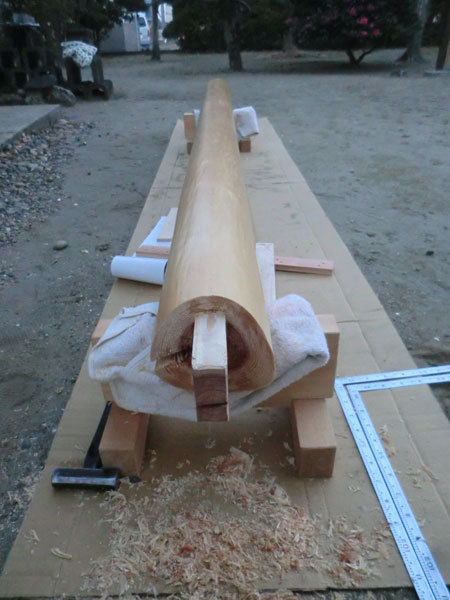
“There is a great satisfaction in building good tools for other people to use.”
Freeman Dyson
This is the second and final post about the heavy-duty Japanese carving gouges.
The Sotomaru Nomi” 外丸鑿 is what is called an “Incannel Gouge” in the West. “Soto” 外 means “outside” or “external,” “maru” 丸 means “round,” and “nomi” 鑿 means “chisel.” The name corresponds closely to the English language term for incannel gouges.
As with other Japanese chisels, the Sotomaru Chisel has a thin layer of high-carbon steel laminated to a softer low-carbon steel body with a neck and tang. They also have the ferrule which compresses the handle’s wood to keep the blade’s tang firmly attached to the handle and prevent the handle from splitting, and a crown to prevent the handle from cracking when struck with a steel hammer. Unlike most Japanese chisels, however, they do not have a hollow-ground ura.
The cutting edges differ from their Western counterparts in that the bevel is a single, flat plane, instead of a curved surface. The advantage of this detail when sharpening would be difficult to overstate. The blade can be sharpened on a normal, flat sharpening stone without pesky slips, finger contortions, or heaven forfend, miniature die grinders.



APPLICATIONS
This is an unusual chisel outside Japan, but is indispensable for working round wood and bamboo used in Japan’s sukiya and teahouse construction traditions. Although this chisel has many advantages, and some disadvantages. For instance, it will not waste wood as rapidly as the uchimaru chisel we looked at in the previous post, but it tends to hold an edge longer and is definitely quicker/easier to make fiendishly sharp. In addition, its shape is much more conducive to cutting precisely curved surfaces than its concave sisters.


Notice also the “sewari” kerf cut into the post in this and the next photo. I will discuss this interesting detail more in a future post, God willing and the creek don’t rise.




The hard steel lamination in this chisel has more support than its brother the uchimaru gouge we looked at in the previous post, making it a bit tougher.
Sharpening is easier and quicker than other gouges because the bevel can be treated as a single flat plane. The area called the “flat” or “ura” on conventional chisels is convex so it can be worked on a flat stone eliminating entirely the need for those pesky grooved stones and slips.
The disadvantage is that the flat bevel/curved cutting edge cannot make clean stopped cuts against 90 degree surfaces. This shortcoming is easily dealt with, however, by making a few more passes.
The sotomaru nomi is perfect for fitting straight line curved surfaces in some situations because its convex surface can ride and index directly on the concave surface being shaped, whereas the more common concave gouge must be tilted at an angle on its axis to cut, with less precision.
Since this chisel can cut parallel to its axis, and does not need to be angled up from the surface being worked to cut, it can cut and carve in much tighter locations than standard gouges.

If you need to make curved cuts at 90° to the workpiece’s surface, as in the photos above, then this chisel is indispensable. I’m sure you can see why this chisel is a must-have for the elegant ” round work” the Japanese love so much.
Another advantage is that the sloped cutting edge can easily make undercuts, something their Western counterpart cannot do. This is an essential performance criteria for accomplishing a few traditional Japanese architectural details such as the edge detail in the beam nose shown in the photo below. Good luck cutting that with a standard gouge!
It’s always nice to have the right tool for the job at hand.
Standard sizes are 9mm, 12mm, 15mm, 18mm, 24mm, 30mm, 36mm, and 42mm.
YMHOS



If you have questions or would like to learn more about our tools, please click the “Pricelist” link here or at the top of the page and use the “Contact Us” form located immediately below.
Please share your insights and comments with everyone in the form located further below labeled “Leave a Reply.” We aren’t evil Google, fascist facebook, or thuggish Twitter and so won’t sell, share, or profitably “misplace” your information. May I gag on a hairball if I lie.
Links to Other Posts in this Series
- The Varieties of Japanese Chisels Part 1 – The Main Categories
- The Varieties of Japanese Chisels Part 2 – The Mentori Oiirenomi (面取追入鑿)
- The Varieties of Japanese Chisels Part 3 – The Shinogi Oiirenomi (鎬追入鑿)
- The Varieties of Japanese Chisels Part 4 – Kakuuchi Oiirenomi (角打追入鑿)
- The Varieties of Japanese Chisels Part 5 – High-Speed Steel Oiirenomi (HSS 追入鑿)
- The Varieties of Japanese Chisels Part 6 – The Mortise Chisel (Mukomachi Nomi 向待鑿)
- The Varieties of Japanese Chisels Part 7 – The Nihon Mukomachi Nomi (二本向待鑿)
- The Varieties of Japanese Chisels Part 8 – The Atsunomi (厚鑿)
- The Varieties of Japanese Chisels Part 9 – The Uchimaru Nomi Gouge (内丸鑿)
- The Varieties of Japanese Chisels Part 11 – The Tsuba Nomi Guard Chisel (鍔鑿)
- The Varieties of Japanese Chisels Part 12 – The Usunomi Paring Chisel (薄鑿)
- The Varieties of Japanese Chisels Part 13 – The Shinogi Usunomi 鎬薄鑿 Paring Chisel
- The Varieties of Japanese Chisels Part 14 – Kote Nomi (鏝鑿Trowel Chisel)
- The Varieties of Japanese Chisels Part 15 – Ootsuki Nomi 大突き鑿
- The Varieties of Japanese Chisels Part 16 – High-speed Steel Atsunomi
- The Varieties of Japanese Chisels Part 17 – Sokozarai Chisel
- The Varieties of Japanese Chisels Part 18 – The Hantataki Chisel